
The Cotswold is a British breed of domestic sheep. It originates in, and is named for, the Cotswold hills of the southern midlands of England. It is a large long-woollen sheep, and is kept as a dual-purpose breed, providing both meat and wool.

The Border Leicester is a British breed of sheep. It is a polled, long-wool sheep and is considered a dual-purpose breed as it is reared both for meat and for wool. The sheep are large but docile. They have been exported to other sheep-producing regions, including Australia and the United States.

The Jacob is a British breed of domestic sheep. It combines two characteristics unusual in sheep: it is piebald—dark-coloured with areas of white wool—and it is often polycerate or multi-horned. It most commonly has four horns. The origin of the breed is not known; broken-coloured polycerate sheep were present in England by the middle of the seventeenth century, and were widespread a century later. A breed society was formed in 1969, and a flock book was published from 1972.

The Shropshire breed of domestic sheep originated from the hills of Shropshire, and North Staffordshire, England, during the 1840s. The breeders in the area used the local horned black-faced sheep and crossed them with a few breeds of white-faced sheep. This produced a medium-sized polled (hornless) sheep that produced good wool and meat. In 1855 the first Shropshires were imported into the United States (Virginia). This breed is raised primarily for meat.
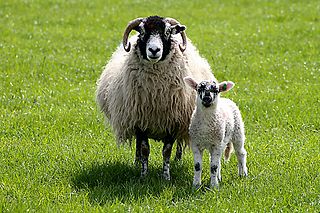
Swaledale is a breed of domestic sheep named after the Yorkshire valley of Swaledale in England. They are found throughout the more mountainous areas of Great Britain, but particularly in the Yorkshire Dales, County Durham, and around the pennine fells of Cumbria.
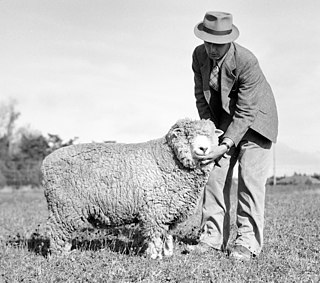
The Corriedale is a New Zealand breed of sheep. It was bred from about 1882 in the South Island by James Little, who cross-bred Merino and Lincoln Longwool sheep. The breed was officially recognised in 1911. It has been exported to Australia and to many countries in Africa, Asia, Europe and North and South America. In 2021 it was reported from twenty-five countries, and the total population was estimated at just over 5 million.
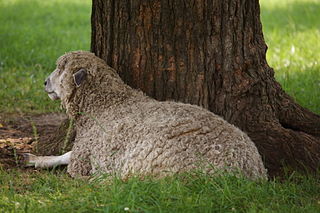
The Leicester Longwool is an English breed of sheep. Alternative names for the breed include: Leicester, Bakewell Leicester, Dishley Leicester, English Leicester, Improved Leicester and New Leicester. It was originally developed by 18th-century breeding innovator Robert Bakewell.

The Dorset Horn is an endangered British breed of domestic sheep. It is documented from the seventeenth century, and is highly prolific, sometimes producing two lambing seasons per year. Among British sheep, it is the only breed capable of breeding throughout the winter.

The Shetland is a small, wool-producing breed of sheep originating in the Shetland Isles, Scotland, but is now also kept in many other parts of the world. It is part of the Northern European short-tailed sheep group, and it is closely related to the extinct Scottish Dunface. Shetlands are classified as a landrace or "unimproved" breed. This breed is kept for its very fine wool, for meat, and for conservation grazing.

The Portland is a sheep breed that takes its name from the Isle of Portland in Dorset, England. This breed is raised primarily for meat.
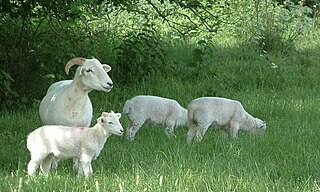
The Wiltshire Horn is a breed of domestic sheep originally from Wiltshire in southern England raised for meat. The breed is unusual among native British breeds, for it has the unusual feature of moulting its short wool and hair coat naturally in spring, obviating the need for shearing. They are good mothers and have high fertility.

The Poll Dorset, a short-wool, meat-producing sheep, was developed in Australia between 1937 and 1954 with the aim of breeding a true Dorset type sheep without horns. The poll gene was introduced into Dorset Horn flocks from two other polled breeds and following a strict back-mating programme achieved close to 100% of Dorset Horn blood. Its main distinguishing features are its hornless appearance, long, lean square body set on short legs, pink skin and 'spongy' short-stapled wool. The Poll Dorset produces a fleece of white, dense downs type wool of 30 microns fibre diameter and it has a white wool-free face. The breed was developed at a property called Valmore in Whitemore, Tasmania, a noted centre for pedigree livestock stud farms. The Poll Dorset resulted from the introduction of Corriedale and Ryeland blood into the Dorset Horn.

The Charollais is a breed of domestic sheep originating in east central France, in the same region in which Charolais cattle originated, Charolles and Saône-et-Loire. It is known for ease of lambing and is used as a terminal sire to increase muscling and growth rate of the lambs. It has been exported internationally, and is commonly used in the United Kingdom as a sire to produce market lambs from pure-bred ewes and mules.

The Boreray, also known as the Boreray Blackface or Hebridean Blackface, is a breed of sheep originating on the St Kilda archipelago off the west coast of Scotland and surviving as a feral animal on one of the islands, Boreray. The breed was once reared for meat and wool, but is now used mainly for conservation grazing. The Boreray is one of the Northern European short-tailed sheep group of breeds.

The Gotland, also called the Gotland Pelt, is a breed of domestic sheep named for the Swedish island of Gotland. A breed of Northern European short-tailed sheep, they are thought to be the product of crossbreeding between the native landrace of the island — called the Gute — with Karakuls and Romanovs during the 1920s and 1930s.
The Devon Closewool is a British breed of domestic sheep. It is distributed almost exclusively on Exmoor in North Devon, in south-west England. It is raised primarily for meat.

The Wiltipoll is a breed of polled domestic sheep that was developed in Australia from Wiltshire Horn sheep with the infusion of Border Leicester, Perendale, Poll Dorset, and Poll Merino genetics, that are raised for meat.
The Eliottdale is a breed of domestic sheep originating from Tasmania. It is a carpet wool breed raised primarily for its wool. Due to the amount of wool grown by the Eliottdale, it needs to be shorn twice per year.
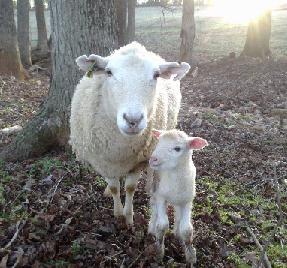
The Polled Dorset is an American breed of domestic sheep. It is a polled (hornless) variant of the British Dorset Horn. It was developed at the North Carolina State University Small Ruminant Unit in the 1950s after a genetic mutation led to the birth of a polled ram. After some years of breeding work, a true-breeding polled strain was established.



















